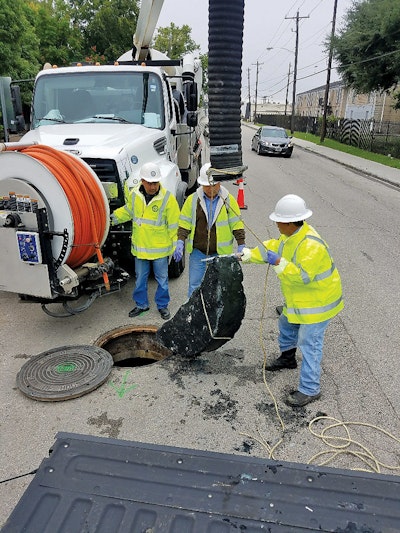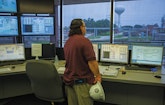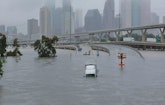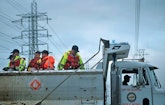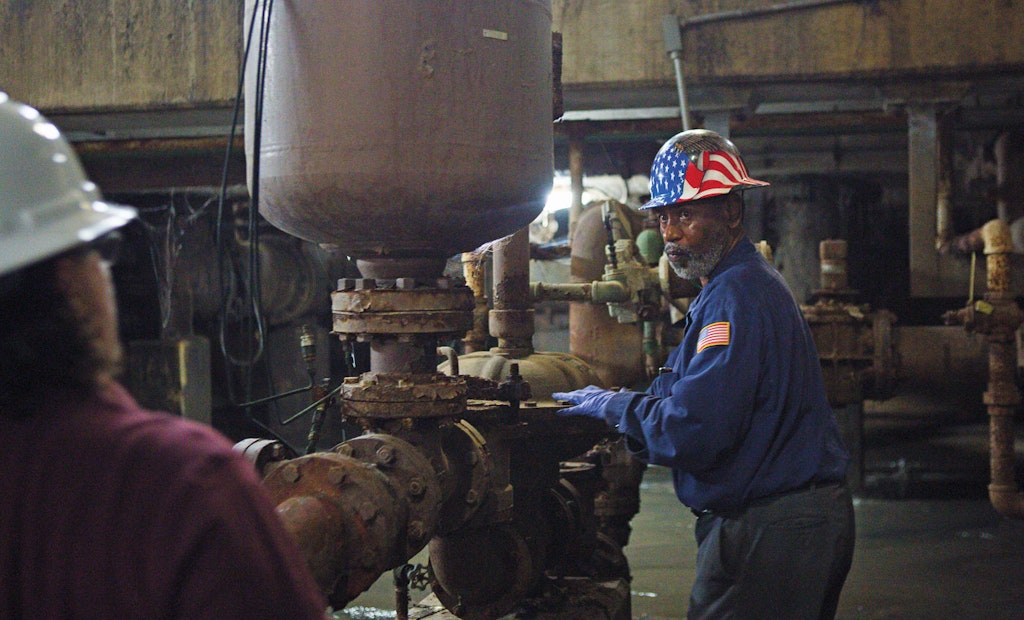
Pedro Munive (left) talks with mechanic Gary Archie about the new heavy solids pumps they will be installing in one of the pump stations at Houston’s 69th Street Wastewater Treatment Plant.
How many wastewater utilities can handle 51 inches of rain in 72 hours?
Probably none. But that’s what challenged the Houston Wastewater Operations service line when Hurricane Harvey drenched South Texas in late August 2017.
The devastating results:
- 18 of 39 Houston wastewater treatment plants underwater
- Electrical circuits and equipment completely soaked
- 30 percent of the collections system totally flooded for nearly a week
- 81 lift stations completely submerged
- And a nonpressurized sewer system turned into a pressurized system by the storm, breaking pipes and joints.
“I’ve been through hurricane winds and hurricane floods before,” says Shannon Dunne, Houston Wastewater’s senior assistant director. “I’ll take the winds every time.”
Today, over a year after the storm, Houston continues to repair and recover its wastewater infrastructure, but it will take a long time. “We’re still assessing the damage and developing solutions, but we’re open for business,” says Clarence Wittwer, assistant director of Wastewater Operations. “But it took about six months for us to return to normal — and it’s a new normal. Things aren’t ever going to be the same.”
The Houston system
Houston’s wastewater system is one of the nation’s largest. It dates to an early lift station sewer and drying bed system installed in 1902 and today serves over 2 million people and covers some 669 square miles. Over 6,100 miles of sewers carry wastewater to 39 different wastewater plants, which together treat about 239 mgd. Permitted maximum capacity is 565 mgd.
The system contains 383 lift stations, 127,000 manholes and three wet-weather facilities.
Under normal operating conditions, Houston rehabilitates about 950,000 linear feet of sewer lines each year, in accordance with a 10-year plan to reduce sanitary sewer overflows. The utility uses a variety of technologies, including sliplining and pipe bursting. The nonstructural component of the plan involves televising and cleaning 30 million linear feet over the 10-year period.
One in a thousand
It had been nine years since the last major hurricane hit the Gulf Coast, but Harvey made up for lost time. The howler came ashore near Corpus Christi on Aug. 25, 2017 with winds of 115 to 130 miles per hour. Soon after, it turned into a monstrous tropical storm that wandered around South Texas for days, dumping record amounts of rain, flooding whole communities and their infrastructure. Treatment plants and systems in as many as 11 counties were partially or completely submerged. It was the wettest tropical cyclone on record in the U.S. and equaled a one-in-1,000-year flood event.
The deluge caused damage and suspended operations throughout Houston’s sprawling wastewater collections and treatment system.
Sewers were among the most serious issues, as 30 percent of the system was underwater for nearly a week, and 10 percent of it was submerged for three to four weeks, including critical lift stations.
A large amount of silt and debris accumulated in the sewers, and many household sewer connections were damaged or even washed away. Wittwer says city crews along with a number of outside contractors have worked for several months to clear the lines. The city is using 2100 Series Vactor combination sewer cleaners, with Subsite Electronics (formerly RST) camera systems, while contractors use similar systems and are required to meet City of Houston Standard Specifications.
The main issue wasn’t that sewage was backing up into homes, since people had left their property and in some cases couldn’t return for weeks.
Rather it was that the amount and weight of the water turned the normal low-flow gravity sewers into pressure sewers, which typically have watertight joints and no manholes. “We went from a nonpressurized to a pressurized system,” Wittwer notes. “Our system is simply not designed for that.”
As a result, Houston continues to deal with many cracked and broken pipes and separated joints.
“We’re not sure we fully understand what happened,” Dunne adds. “And we’re just starting to see the extent of the long-term damage. We can’t televise 6,200 miles of sewer all at once.”
The problems have been compounded by sinkholes that have caused pipes as large as 100 inches in diameter to shift and break. “There’s been a lot of settlement across the whole zone,” Dunne says.
Washout
While entire sections of the city’s collections network were affected by the storm, the most serious situation occurred in the area of the Buffalo Bayou — normally a slow-moving river that flows through the city. Dunne explains that as the flood-water built up, certain reservoirs had to release water, as required by federal law. The rushing water eroded a whole section of bank along a right-of-way, taking inverted siphons, aerial crossings, and about a mile of 42-inch sewer pipe.
“The bank was about 30 feet wide and 50 feet deep,” Wittwer explains. “That 42-inch line was simply gone. We had to install three bypasses (to carry wastewater) while it took about four months to rebuild the bank. People literally had the Bayou in their backyards.”
The city’s treatment plants didn’t escape the flooding. Nearly half were flooded out, forcing the Houston staff to shut them down, and wait — oftentimes stranded — for the floodwater to recede. “Two of our major treatment plants were completely submerged under 6 to 8 feet of water for two weeks,” Dunne says.
Like the collections system, some of the plants have experienced subsidence from the weight of the water and the downward pressure.
Mobile equipment
In some cases, the normal treatment plant systems were so flooded that mobile equipment had to be brought in while the fixed equipment dried out.
“We brought in temporary clarifiers, temporary aeration systems and temporary pump stations. It was almost like a package plant,” Dunne says. “We had to piecemeal the West District and Turkey Creek facilities back together so we could resume treatment.”
The city put out a call for assistance from vendors and selected Aqua Tecture to provide the equipment until operations could be resumed.
While most facilities were back online within one day, plants that were completely flooded could not return to normal operations until all the electrical and mechanical equipment had been evaluated. Gearboxes on blowers and clarifiers needed to be purged of all the contaminated oil and needed to have new oil put in its place.
Dunne says the electrical switchgear and motors needed to be dried out and some components replaced due to damaged parts. “We had to replace a couple of transformers, PLCs, starters, relays, some motors that went to ground, coils, ground fault relays, and GFI receptacles, and repull some wire.”
Even then, the water damage has made much of the electrical equipment unreliable.
“In the last few months, a lot of electrical failures have popped up, randomly,” Dunne says.
“It’s like Russian roulette. We know a circuit or piece of equipment is going to fail; we just don’t know when. Just in the last three months, we’re starting to experience a lot of failures.” He says blowers, motors, electrical panels — all are affected.
“It’s like if you drop your cellphone into the water: It will eventually dry out, but it may act crazy.”
Looking ahead
So where does Houston Wastewater go from here? “You can’t keep Houston folks down,” Dunne says. “They get to work (and address the problems). We’re open for business, overcoming the hurdles piece by piece. The city doesn’t work without wastewater.
“Still,” he says, “there is concern about another flood in the future.
“We’re going to see a lot of pipes and plants being moved above the flood plain, and a lot of new tunnels to store stormwater. We’ve hired 43 outside consulting firms to make an assessment of the whole system, at a cost of $20 million. We’ll decide what to fix, what to harden, what to eliminate. It could take up to 10 years.
“The mayor and city government are closely involved in preparing for future floods. We’ll be better at controlling water.”
To that end, Houston voters recently passed a $2.5 billion bond issue to address future flooding problems. As Dunne predicted before the vote, the support was nearly unanimous, with more than 85 percent of voters approving the funding.
Those bonds will be used to fund 237 projects, including three large detention basins across the county.
“We understand more floods may be coming,” Wittwer says. “But we’re not just going to build back. We’re going to build it better.”
The toll on people
Hurricane Harvey took its toll on people as much as it did on facilities — including wastewater customers as well as the operators and management at the Houston Wastewater Department.
“We set up an emergency response system on our 311 phone line,” explains Shannon Dunne, senior assistant director. “And we had extra people on as emergency operators.
“But we didn’t get a huge increase in calls,” he says. A lot of that resulted from the fact that people in the most affected areas weren’t in their homes.
“In some of the neighborhoods, the homes were empty for almost a month,” adds Clarence Wittwer, assistant director of Wastewater Operations. “It was search and rescue. We used airboats, dump trucks, water vehicles of every type.
“I think overall, our customers were very accepting of our efforts.”
The treatment and collections staffs were likewise affected, some doubly so. “A lot of our operators’ homes were flooded, too,” Dunne says. “They weren’t able to go home so they stayed at the plants.”
Dunne says the department has about 800 people. “We rotated on 12-hour shifts,” he explains. “The city paid overtime and gave comp time to salaried employees and provided people the staff could talk to. But the crews just needed rest. Fatigue was tough.”
Dunne and Wittwer agree the staff was totally committed to helping customers. “Our crews were outstanding,” Dunne says. “Once the water went down, they were like ants running around and fixing things.”
Crews used CCTV to locate point repairs. They filled major sinkholes. “Once we assessed damage, our crews often had things up and running, 24/7,” Dunne says.
“The first responders cleaned things up as well as they could. Then we had contractors come in and repair pipes,” Wittwer says.
“Some of the areas stayed flooded for over a month. Many employees worked 28 days straight after the storm. After that, we finally got a chance to breathe.”
“Wastewater here is a family,” Dunne adds. “We leaned on each other; we stuck together.”
